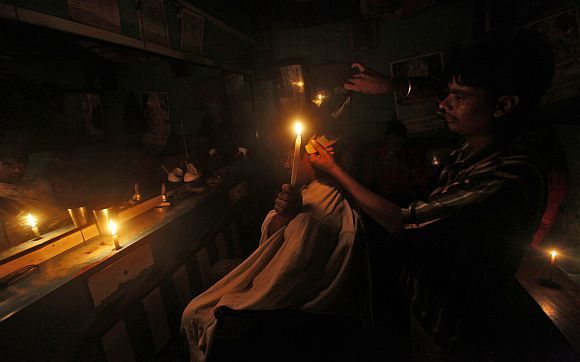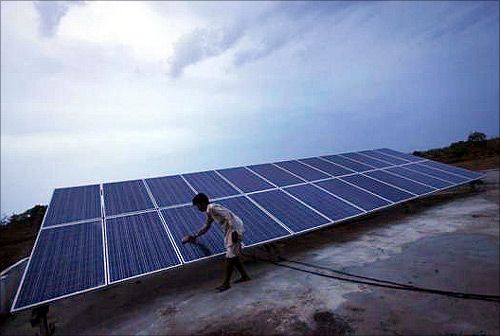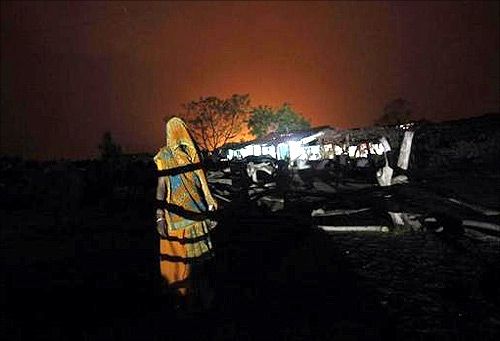 | « Back to article | Print this article |
Around 80 mn rural households are estimated to have no access to grid power.
Off-grid decentralised systems, based on renewable energy, are lighting up around 1,000 villages through government funding.
In the first of a two-part series, Jyoti Mukul travels to remote villages in Bihar's Araria district to see how micro-grids are providing a reliable source of power to small businesses and rural households.

Till a few months ago, two litres of subsidised kerosene a month was all that was needed to light a bulb and charge a mobile phone for three hours in the evening.
Not that kerosene was used to generate power; it was a barter of sorts, with kerosene traded for a few hours of electricity.
The owner of a diesel-powered genset would sell the kerosene in the open market at higher rates, turning subsidised kerosene into a booming business in this un-electrified village in Bihar's Araria district.
The barter translated into a payment of roughly Rs 32 a month.
In January this year, a lot changed. Mahalgaon got a 30-Kw photovoltaic solar power plant, with 100 panels.
A local police station is one of the customers of Decentralised Energy Systems India Pvt Ltd (DESI Power), which runs the micro grid, just across the road. "We give power to 43 commercial establishments for the whole day and, at night, to 176 households from 6 pm to 10 pm. The police station is one of our anchor clients," says S N Sharan, managing director, DESI Power.

These are micro grids, used for the electrification of villages not yet connected to the main transmission grid. With renewable source of power, these are considered ideal off-grid solutions in a host villages, including those in Bihar, Uttar Pradesh and Madhya Pradesh.
In Madhya Pradesh, for instance, 17 villages have micro grids under a programme funded by the Union government-controlled Rural Electrification Corporation (REC) and the state government.
According to an estimate by a senior REC executive, about 1,000 villages have been funded for off-grid renewable energy-based power systems since 2008.
Another 600 are expected to be added to the list soon. "One of the criteria for approving the projects is viability. The operator has to maintain and sustain it for at least five years," says the REC executive.

Sharan says though DESI Power is yet to completely recover its costs, it is likely to start making profits in three years.
Its model is designed to cross-subsidise households with commercial connections; these charge households Rs 2 for two lights and a mobile charging point every day, which translates into Rs 60 a month.
Commercial establishments have to pay at least Rs 250 a month for 10 units of power. "It is difficult to sustain only on domestic connections; so, we are looking for anchor load from mobile towers, petrol pumps, ATMs, pump sets and cold storages," Sharan says.
By contrast, in Madhya Pradesh, where the systems are funded by the government, Rs 15 a month is charged from households below the poverty line and Rs 60 from those above it. Commercial establishments and water pump users have to pay Rs 800-1,500.
Dharam Nath Yadav and Sunil Kumar Yadav are two commercial customers of DESI Power in Mahalgaon.

While Dharam Nath runs a mobile repair and computer shop, Sunil is a tailor. Now, they can work for longer hours. Since January when the micro grid brought them power, they have stopped using diesel gensets.
"I used to burn at least one to two litres of diesel in the genset earlier. Now, I hardly use it; I've kept it as a back-up," says Dharam Nath. DESI Power is a partner of Smart Power India, an initiative of Rockefeller Foundation, which last year announced an investment of $75 million in micro grids across the country.
"There are 1,000 operational and under-construction micro grids funded by us. We do it both as an investor and as part of philanthropy. Since there was no institutional mechanism available for mini grids, we launched Smart Power Initiative," says Ashvin Dayal, president (Asia), Rockefeller Foundation.
Jaideep Mukherjee, chief executive of Smart Power India, says cell towers could be anchor customers to make business sustainable for micro grids. "We want to create energy supply companies. The effort is to build and operate these in a way that these should be making profits; otherwise, a lot of companies find it difficult to sustain."
The advantage of such solar power micro grids lies in the fact that these are modular and can be scaled up easily. DESI Power earns Rs 40,000-42,000 a month from the Mahalgaon unit.

It has 22 such units, some of which work on a hybrid of biomass and solar. At Bhebhra in Jokihat, DESI Power runs a biomass plant that feeds the micro industry and supplies power for evening lighting. Mohammad Qasim, who runs a small flour mill and masala unit, is a commercial customer.
He doesn't mind paying Rs 16.50 a unit for power, as it is reliable. He employs six people and says he makes Rs 40,000-50,000 a month during the busy season.
With 20-50-Kw capacity, DESI Power's micro grids run efficiently only within 800 metres. For households outside this area, the company looks at tiny grid solutions with a capacity of 1.5-3.5 Kw, unlike rooftop solar, which is usually used in urban areas and has a capacity of 3.5-10 Kw.
Sharan says their only competitor, whenever it emerges, will be grid power, for which, rural electrification is more of a loss-making business.
Compared to grid power, such electrification is more expensive for consumers but even in an electrified village such as the neighbouring Lokhariya, a micro grid is perceived as more reliable, especially in the evening, when grid power is switched off.
Besides, as Sharan puts it, the purpose of running these systems is not only energy solution, but integration of a village.